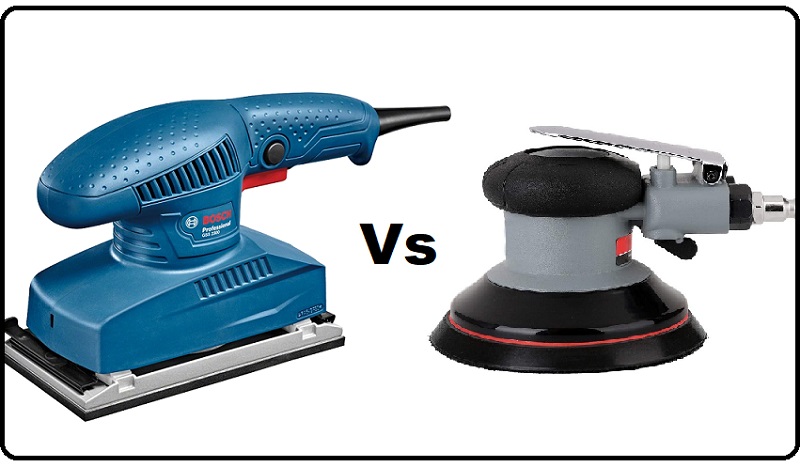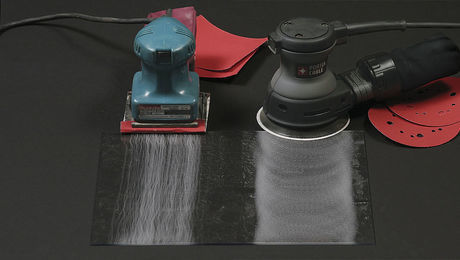Got a DIY project on the horizon? Wondering if an orbital sander is better than a sheet sander? Well, you’ve come to the right place! In this article, we’ll explore the pros and cons of both sanders and help you decide which one suits your needs best. So, let’s dive in and get sanding!
Sand, sand, sand! It may not be the most glamorous part of a project, but it’s crucial for achieving a smooth and polished finish. Now, when it comes to sanders, you’ve got options. Two popular choices are orbital sanders and sheet sanders. But which one reigns supreme?
First up, the orbital sander. This handy tool uses a circular motion to spin a sanding pad, making it ideal for tackling larger surface areas. It’s like the energizer bunny of sanding, effortlessly zipping through projects with speed and precision. But is it better than its counterpart, the sheet sander? Stay tuned to find out!
When comparing an orbital sander and a sheet sander, it’s important to consider their unique features. The orbital sander is known for its versatility, making it great for sanding curves and contours. On the other hand, the sheet sander is ideal for large, flat surfaces. Additionally, the orbital sander offers better stock removal capabilities, while the sheet sander provides a superior finish. Ultimately, the choice between the two depends on the specific project requirements and personal preferences.

Comparing Orbital Sanders and Sheet Sanders: Which One Comes Out on Top?
When it comes to sanding wood or other surfaces, having the right tool for the job is essential. Two popular choices in the world of sanding are orbital sanders and sheet sanders. Both options have their pros and cons, and understanding the differences between the two can help you make an informed decision. In this article, we’ll delve into the features, benefits, and best uses of both orbital sanders and sheet sanders. By the end, you’ll have a better understanding of which tool is the better fit for your sanding needs.
Orbital Sanders: Power and Versatility
Orbital sanders are known for their power and versatility. They use a circular sanding pad that moves in a random or elliptical pattern, providing a smooth and consistent finish. The random orbital motion of the pad prevents swirl marks and ensures an even sanding result. This makes orbital sanders ideal for sanding large areas, such as floors or tabletops.
One of the key advantages of orbital sanders is their ability to handle different types of surfaces and materials. Whether you’re sanding wood, metal, or plastic, an orbital sander can get the job done. They also excel at removing paint or varnish from surfaces. The versatility of orbital sanders makes them a great choice for both professional contractors and DIY enthusiasts.
However, it’s important to note that orbital sanders are generally heavier and bulkier compared to sheet sanders. This can make them harder to maneuver in tight spaces or for extended periods. Additionally, orbital sanders are typically more expensive than sheet sanders, which may be a consideration for budget-conscious individuals.
Sheet Sanders: Portability and Precision
If you’re looking for a sanding tool that is lightweight, portable, and easy to handle, a sheet sander might be the right choice for you. Sheet sanders feature a rectangular or square-shaped sanding pad, typically made of sandpaper or abrasive sheets. The straight-line motion of the pad provides precise sanding control, making sheet sanders perfect for refining small areas or intricate details.
Sheet sanders are also great for sanding in corners or tight spaces that orbital sanders may struggle to reach. The compact size and maneuverability of sheet sanders make them a popular choice among hobbyists or those who work on smaller projects.
One drawback of sheet sanders is that they are less powerful compared to orbital sanders. This means they may take longer to sand larger areas or remove stubborn paint or varnish. However, if precision and portability are your priorities, a sheet sander is an excellent option.
Benefits of Each: Finding Your Perfect Fit
Benefits of Orbital Sanders
1. Versatility: Orbital sanders can handle various surfaces and materials, making them a versatile choice for different projects.
2. Smooth Finish: The random orbital motion of the sanding pad ensures an even and swirl-free finish.
3. Power: Orbital sanders are known for their power and ability to remove paint or varnish effectively.
Benefits of Sheet Sanders
1. Portability: Sheet sanders are lightweight and easy to maneuver in tight spaces or for prolonged periods.
2. Precision: The straight-line motion of the sanding pad provides precise control, making sheet sanders ideal for detailed work.
3. Cost: Sheet sanders are typically more affordable compared to orbital sanders, making them a budget-friendly choice.
Orbital Sander vs. Sheet Sander: Which Should You Choose?
Projects
If you often work on large surfaces and need to remove paint or varnish, an orbital sander is the better option. Its power and versatility make quick work of such tasks. On the other hand, if you mainly work on smaller projects or require precision sanding, a sheet sander will serve you well.
Price
If you’re on a tight budget, a sheet sander is the way to go. They are generally more affordable than orbital sanders, making them a great choice for occasional DIY users.
Mobility
If you need a sander that is lightweight and easy to handle, a sheet sander is your best bet. Its compact size and portability make it perfect for sanding in tight spaces or for extended periods of time.
Noise and Vibration
Orbital sanders tend to be louder and produce more vibration compared to sheet sanders. If noise is a concern or if you want a smoother sanding experience, a sheet sander may be the better choice.
Dust Collection
Some orbital sanders come with built-in dust collection systems or can be connected to a vacuum. This helps minimize dust and keeps the work area cleaner. If you prioritize dust control, an orbital sander is the way to go.
Tips for Getting the Most Out of Your Sander
Tips for Orbital Sanders
1. Use the appropriate grit sandpaper for your project to achieve the desired finish.
2. Apply even pressure and let the sander do the work. Excessive pressure can lead to uneven sanding or overheating.
3. Move the sander in a controlled manner, following the grain of the wood for the best results.
Tips for Sheet Sanders
1. Change the sandpaper regularly to maintain optimal performance.
2. Sand in a steady, straight line to ensure an even finish.
3. Pay attention to the corners and tight areas, as sheet sanders are great for reaching these spots.
In conclusion, whether an orbital sander or a sheet sander is better depends on your specific needs and preferences. Both tools have their strengths and weaknesses, so it’s important to consider the type of projects you’ll be working on, your budget, and your desired level of precision. By understanding the benefits and features of each sander, you can make an informed decision and achieve outstanding sanding results every time.
Key Takeaways: Is Orbital Sander Better Than a Sheet Sander?
- Orbital sanders are generally better for removing stock quickly and efficiently.
- Sheet sanders are great for smooth, fine finishes and detail work.
- An orbital sander moves in a circular motion, while a sheet sander moves back and forth.
- Orbital sanders are easier to control and less likely to leave swirl marks on the surface.
- Sheet sanders are more affordable and versatile, suitable for a variety of projects.
Frequently Asked Questions
If you’re wondering about the differences between an orbital sander and a sheet sander, you’re in the right place! Here are some common questions answered to help you understand which one is better for your needs.
1. What is the main difference between an orbital sander and a sheet sander?
The main difference lies in their sanding actions. An orbital sander moves in a circular motion, while a sheet sander moves in a back-and-forth motion. This difference affects how they remove material from the surface. Orbital sanders create a random pattern, reducing the risk of leaving marks on the workpiece. On the other hand, sheet sanders excel at sanding large, flat surfaces efficiently due to their straightforward motion.
TL;DR: Orbital sanders have a circular motion and create less visible marks, while sheet sanders have a back-and-forth motion and are great for large, flat surfaces.
2. Which type of sander is better for removing paint?
When it comes to removing paint, an orbital sander is your best bet. Its circular motion, combined with the abrasive pads or sandpaper, efficiently strips away the paint without damaging the underlying surface. The random pattern of the sanding motion also avoids leaving visible swirl marks. With the right grit size, an orbital sander can make paint removal a breeze.
However, it’s important to note that the type of paint, surface condition, and personal preference can influence your choice. If you’re working with delicate surfaces or want more control, a sheet sander might be a better option.
3. Can an orbital sander be used for finishing work?
Absolutely! Orbital sanders are widely used for finishing work. Their random orbital motion ensures a smooth sanding action, minimizing the chances of leaving visible sanding marks or scratches. They are particularly effective in creating a fine and consistent finish on wood, removing imperfections, and preparing the surface for painting or staining.
With different grit sizes, you can use an orbital sander to achieve various levels of smoothness, from rough sanding to ultra-smooth finishes. It’s important to choose the right sanding pad or sandpaper grit for your specific project to achieve optimal results.
4. When should I choose a sheet sander over an orbital sander?
If you’re working on a project that involves sanding large, flat surfaces, a sheet sander is a great choice. The back-and-forth motion of a sheet sander covers more area efficiently, making it easier and faster to sand wide surfaces like tabletops, doors, or floors.
Sheet sanders also provide better control when sanding delicate or smaller areas due to their linear sanding motion. If you want to selectively sand a specific spot or need more precision, a sheet sander can be the right tool for the job.
5. Are there any safety considerations when using these sanders?
Yes, safety should always be a priority when using power tools. Regardless of whether you’re using an orbital sander or a sheet sander, make sure to wear protective goggles, a dust mask, and earmuffs or earplugs to shield yourself from airborne particles and noise.
Additionally, always follow the manufacturer’s instructions and guidelines for safe usage. Securely hold the sander with both hands, keeping a firm grip, and avoid applying excessive pressure on the workpiece, as it may increase the risk of accidents or damage the sander or material.
TL;DR: Wear protective gear, follow safety guidelines, and avoid excessive pressure when using either type of sander.

Painful lessons learned – Random Orbit vs. 1/4-Sheet Sanders
Summary
So, which sander is better: the orbital sander or the sheet sander? Well, it really depends on what you need it for. If you want to remove a lot of material quickly, the orbital sander is the way to go. It’s powerful and efficient. But if you’re looking for precision and control, the sheet sander is your best bet. It’s great for smoothing surfaces and tackling smaller projects. Ultimately, it’s all about choosing the right tool for the job!
